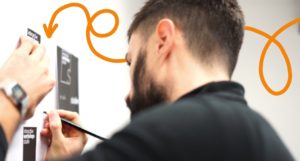“You can’t use up creativity. The more you use, the more you have.”
Maya Angelou: Author, poet, civil rights activist
There are many tasks that can be performed under a great deal of pressure, but to come up with something that answers the brief, is original and looks great requires practice and a shift into a different mindset.
During my time working in the IW Studio, I had to reconsider what I thought would be doable in a given amount of time — often, I would be sure that there was no possible way to deliver something that complex within such a limited time.
I had to change how I approached each task: from how much time I thought I needed to complete it to my own standards, to what was the best quality artwork I can deliver in the available timeframe.
I was a firm believer that good design and the agile methodology were incompatible by nature. Creativity, I would repeat to myself, demands time and cannot be rushed. You might remember situations when you came up with an exceptional (or revolutionary) idea and these were the ones where you allowed yourself time to experiment in several directions and the luxury of thinking about other things too. In short, you were allowing your mind to wander almost freely as opposed to forcing it to find a solution (or idea).
I was wrong. In fact, whilst more complex projects do need some extra time to reach completion in a successful way, most of the tasks I undertake as a designer can be done in an agile way. This means that the piece of work is divided into shorter tasks with regular opportunities for review. So now, instead of going away and spending a week in drafting the layout of a brochure, I require myself and my team to perform shorter sprints of creativity. These are short enough to avoid any unpleasant stress and generate the time for frequent review meetings, thus preventing you from spending too much time on one task without receiving any feedback.
But more than that, having very specific (and tight) boundaries can stimulate true creativity. Nowadays, there is very little that cannot be found on Pinterest, Instagram or Google when you’re in need of inspiration or simply need some fresh ideas. And there is potentially no limit to the time that can be spent exploring those ideas.
But that actually doesn’t require any particular skill. The next time you come across a beautiful poster or an intriguing book or website, think about how much time they have probably spent on it — and then ask yourself: what is the value of this artwork? Designing a great poster in one month is a skill many designers master; designing something equally powerful or impactful in a day requires something outside of the ordinary.

This is where my experience at IW comes in. I like to think that I’m now mastering a different set of skills — skills that allow me to pinpoint the most promising direction for every artwork to be designed.
Because of the time constraints, when working in an agile environment, you can quickly identify the techniques that can be used and you can narrow your focus to those few aspects that will make the difference. In a way, you will be going for what is fundamentally the skeleton of a great piece of design and less for what’s pure and a time-consuming ornament.
This is why it is not only possible to be creative under pressure, but also why what we achieve when challenged by many constraints is true creativity, and we generate truly fresh ideas that create innovation.
